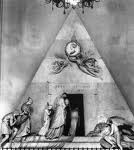[This is taken from Augustine Calmet's Phantom World, originally published in 1850, revised and edited by D. J. McAdam, 2010. Copyright as such.]

A shopkeeper of the Rue St. Honoré, at Paris, had promised his daughter to one of his friends, a shopkeeper like himself, residing also in the same street. A financier having presented himself as a husband for this young girl, was accepted instead of the young man to whom she had been promised. The marriage was accomplished, and the young bride falling ill, was looked upon as dead, enshrouded and interred. The first lover having an idea that she had fallen into a lethargy or a trance, had her taken out of the ground during the night; they brought her to herself and he espoused her. They crossed the channel, and lived quietly in England for some years. At the end of ten years, they returned to Paris, where the first husband having recognized his wife in a public walk, claimed her in a court of justice; and this was the subject of a great lawsuit.
The wife and her (second) husband defended themselves on the ground that death had broken the bonds of the first marriage. The first husband was even accused of having caused his wife to be too precipitately interred. The lovers foreseeing that they might be non-suited, again withdrew to a foreign land, where they ended their days. This circumstance is so singular that our readers will have some difficulty in giving credence to it. I only give it as it is told. It is for those who advance the fact to guarantee and prove it.
Who can say that, in the story of Phlegon, the young Philinium was not thus placed in the vault without being dead, and that every night she came to see her lover Machates? That was much easier for her than would have been the return of the Parisian woman, who had been enshrouded, buried, and remained covered with earth, and enveloped in linen, during a pretty long time.
The other example related in the same work, is of a girl who fell into a trance and was regarded as dead, and became enceinte during this interval, without knowing the author of her pregnancy. It was a monk, who, having made himself known, asserted that his vows should be annulled, he having been forced into the sacred profession. A great lawsuit ensued upon it, of which the documents are preserved to this day. The monk obtained a dispensation from his vows, and married the young girl.
This instance may be adduced with that of Philinium, and the young woman
of the Rue St. Honoré. It is possible that these persons might not be dead,
and consequently not restored to life.
Disclosure: We are independently owned and the opinions expressed here are our own. We do have advertisements with links to other sites on our pages, and may receive compensation when you click on one of those links and/or purchase something from one of those sites.
Copyright © D. J. McAdam· All Rights Reserved